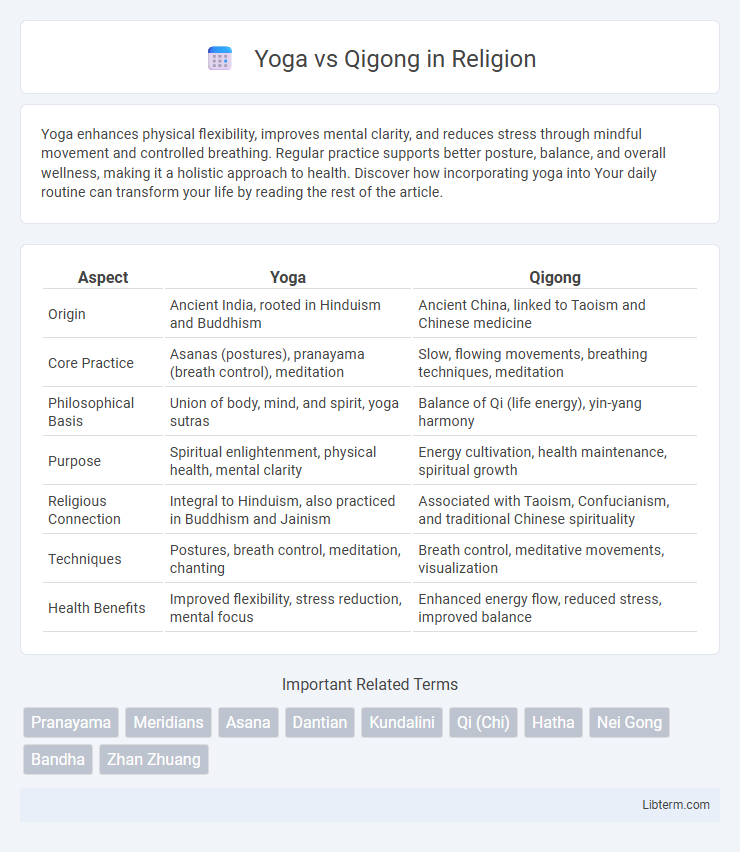Yoga enhances physical flexibility, improves mental clarity, and reduces stress through mindful movement and controlled breathing. Regular practice supports better posture, balance, and overall wellness, making it a holistic approach to health. Discover how incorporating yoga into Your daily routine can transform your life by reading the rest of the article.
Table of Comparison
| Aspect | Yoga | Qigong |
|---|---|---|
| Origin | Ancient India, rooted in Hinduism and Buddhism | Ancient China, linked to Taoism and Chinese medicine |
| Core Practice | Asanas (postures), pranayama (breath control), meditation | Slow, flowing movements, breathing techniques, meditation |
| Philosophical Basis | Union of body, mind, and spirit, yoga sutras | Balance of Qi (life energy), yin-yang harmony |
| Purpose | Spiritual enlightenment, physical health, mental clarity | Energy cultivation, health maintenance, spiritual growth |
| Religious Connection | Integral to Hinduism, also practiced in Buddhism and Jainism | Associated with Taoism, Confucianism, and traditional Chinese spirituality |
| Techniques | Postures, breath control, meditation, chanting | Breath control, meditative movements, visualization |
| Health Benefits | Improved flexibility, stress reduction, mental focus | Enhanced energy flow, reduced stress, improved balance |
Introduction to Yoga and Qigong
Yoga and Qigong are ancient mind-body practices originating from India and China, respectively, emphasizing breath control, meditation, and physical postures to enhance mental and physical well-being. Yoga combines asanas (postures), pranayama (breath control), and dhyana (meditation) to promote flexibility, strength, and spiritual growth, while Qigong integrates gentle movements, breathing techniques, and focused intention to cultivate and balance life energy (Qi) for health and vitality. Both disciplines support stress reduction, improved circulation, and holistic healing through mindful movement and breath awareness.
Historical Roots and Cultural Origins
Yoga originated over 5,000 years ago in ancient India, deeply rooted in Hindu philosophy and the Vedic tradition, emphasizing spiritual growth, meditation, and physical postures (asanas). Qigong, with a history spanning more than 4,000 years in China, derives from Taoist, Buddhist, and Confucian practices, focusing on cultivating vital energy (Qi) through controlled breathing, movement, and meditation. Both disciplines reflect their distinct cultural origins, with Yoga integrating spiritual union and self-realization, while Qigong centers on harmonizing body, mind, and energy flow based on Chinese medicine principles.
Core Philosophies and Principles
Yoga centers on the integration of body, mind, and spirit through asanas, pranayama, and meditation rooted in ancient Indian philosophy emphasizing self-realization and union with the divine. Qigong originates from Traditional Chinese Medicine and Taoist philosophy, highlighting the cultivation and balance of vital energy (qi) through coordinated breathing, movement, and mindfulness. Both practices prioritize holistic health but differ in their metaphysical frameworks: Yoga's focus is on achieving spiritual enlightenment, while Qigong aims to harmonize internal energy for physical and mental well-being.
Key Differences in Practice
Yoga emphasizes a series of asanas (postures) combined with controlled breathing (pranayama) and meditation to enhance flexibility, strength, and mental focus. Qigong centers on fluid, repetitive movements synchronized with deep breathing to cultivate and balance qi (life energy) for holistic health and stress reduction. While yoga often integrates static holds and spiritual philosophies like Hinduism, Qigong is rooted in Traditional Chinese Medicine and emphasizes energy flow through meridians without strenuous physical exertion.
Physical Benefits: Yoga vs Qigong
Yoga enhances flexibility, strength, and balance through dynamic postures and isometric holds that target major muscle groups. Qigong emphasizes gentle, flowing movements and controlled breathing to improve circulation, reduce muscle tension, and promote joint mobility. Both practices support physical health but differ in intensity and focus, with Yoga being more strength-oriented and Qigong prioritizing relaxation and low-impact movement.
Mental and Emotional Health Impacts
Yoga enhances mental clarity and emotional balance through breath control and mindful movement, reducing stress and anxiety by activating the parasympathetic nervous system. Qigong cultivates inner energy flow (Qi) that promotes emotional resilience and mental calmness, helping to alleviate depression and improve mood stability. Both practices encourage present-moment awareness and foster a harmonious mind-body connection essential for mental and emotional well-being.
Spiritual Aspects Compared
Yoga emphasizes the union of body, mind, and spirit through practices like meditation, breath control, and physical postures rooted in Hindu philosophy. Qigong centers on cultivating and balancing Qi (vital energy) through gentle movements, breath regulation, and meditation based on traditional Chinese medicine and Taoist principles. Both promote spiritual growth, but Yoga targets self-realization and enlightenment, while Qigong focuses on harmonizing internal energy and achieving longevity.
Suitability for Different Lifestyles
Yoga offers versatility with styles ranging from intense vinyasa flows to gentle restorative practices, making it suitable for active individuals and those seeking stress relief. Qigong emphasizes slow, meditative movements and breath control, aligning well with people needing low-impact exercise and mental relaxation. Both disciplines can be adapted to fit busy schedules, but yoga often requires more physical space and attire, whereas qigong can be practiced anywhere without special equipment.
Which Practice Is Best for You?
Choosing between Yoga and Qigong depends on your fitness goals and personal preferences; Yoga emphasizes flexibility, strength, and balance through diverse postures and breath control, while Qigong focuses on gentle movements, energy flow, and meditation for stress reduction and healing. If you seek a dynamic workout combined with mindfulness, Yoga offers various styles like Vinyasa or Ashtanga to match your intensity level. For those prioritizing relaxation, improved energy circulation, and holistic wellness, Qigong's slow, intentional exercises cultivate internal harmony and are accessible to all ages and fitness levels.
Conclusion: Integrating Yoga and Qigong
Integrating Yoga and Qigong enhances physical flexibility, mental clarity, and energy flow by combining the dynamic postures of Yoga with the slow, meditative movements of Qigong. This synergy supports holistic wellness, promoting balance between body, mind, and breath. Practitioners benefit from improved circulation, stress reduction, and increased mindfulness through a consistent practice that incorporates elements from both disciplines.
Yoga Infographic

 libterm.com
libterm.com